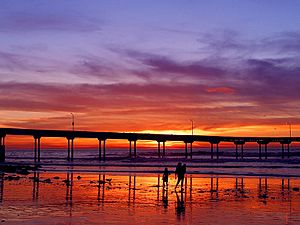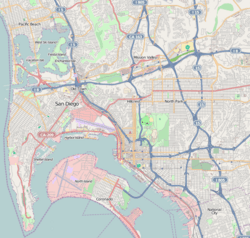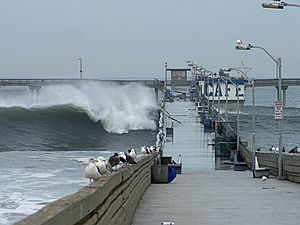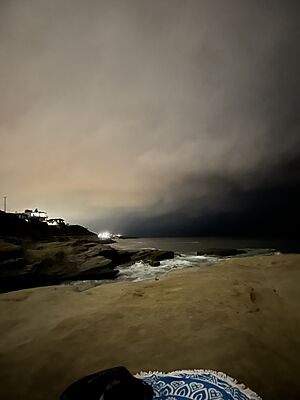Ocean Beach, San Diego facts for kids
Quick facts for kids
Ocean Beach, San Diego
OB
|
|
|---|---|
| Ocean Beach | |

The Ocean Beach Pier at sunset
|
|
| Country | United States |
| State | California |
| County | San Diego |
| City | San Diego |
| Area | |
| • Land | 1 sq mi (3 km2) |
| Population
(2019)
|
|
| • Total | 31,223 |
| Website | https://oceanbeachsandiego.com/ |
Ocean Beach (often called O.B.) is a lively beachfront neighborhood in San Diego, California. It's known for its relaxed vibe and beautiful ocean views. Many people enjoy surfing, walking on the pier, and exploring the unique shops here.
Contents
Exploring Ocean Beach's Location
Ocean Beach is right on the Pacific Ocean. It sits where the San Diego River meets the sea. You can find it about 7 miles (11 km) northwest of downtown San Diego. It is located south of Mission Bay and Mission Beach. To its north is the Point Loma area.
The community covers about 1 square mile (2.6 square kilometers). Its borders are the San Diego River to the north and the Pacific Ocean to the west. On the east, it's bordered by Froude St., Seaside St., and West Point Loma Boulevard. Adair Street forms its southern edge.
Ocean Beach's Past: A Look Back
Early Days and Naming
Long ago, before Europeans arrived, the Kumeyaay people lived in this area. They had a fishing camp called Hapai. They gathered mussels, clams, abalone, and lobsters from the ocean.
The beach was first called Mussel Beach because of all the mussels found there. In 1887, two developers, Billy Carlson and Albert E. Higgins, gave it the name Ocean Beach.
Building a Community
Carlson and Higgins built a resort hotel called the Cliff House. They divided the land into lots to sell. To attract people, they held fun events like mussel roasts and concerts. However, it was hard to get to Ocean Beach from downtown San Diego. The development slowed down, and the Ocean Beach Railroad, started in 1888, didn't last. The Cliff House later burned down in 1898.
Another important person was D. C. Collier. He bought land in Ocean Beach when he was just 16 in 1887. He helped plan the streets and encouraged people to buy property. In 1909, he built the Point Loma Railroad. This train connected Ocean Beach to the rest of San Diego. By 1910, Ocean Beach had grown to 100 houses. Collier also built Ocean Beach Elementary School and gave land for parks.
Wonderland Amusement Park
In the early 1900s, a fun place called Wonderland Amusement Park opened. It was built on the oceanfront in 1913. The park had a big roller coaster, a dance hall, and a petting zoo with many animals. It even had 22,000 lights to make it sparkle at night.
However, Wonderland closed in 1916. It faced competition from another big event, the Panama–California Exposition. Winter storms also damaged the roller coaster. Today, some local businesses still use the name "Wonderland" to remember the park.
Connecting with a Bridge
In 1915, a long wooden bridge was built. It connected Ocean Beach with Mission Beach. This bridge carried a trolley that linked Ocean Beach to downtown San Diego. This helped both communities grow. The bridge was taken down in 1951. This made Ocean Beach feel a bit more separate from other beach towns.
Surfing History
Surfing first came to San Diego at Ocean Beach in 1916. A local lifeguard borrowed a surfboard from a famous surfer named Duke Kahanamoku. By 1966, surfing was so popular that the World Surfing Championship was held in Ocean Beach. Nat Young won the event and became the world champion.
A Time of Change
In the 1920s, there was a time when selling certain drinks was not allowed. This law was meant to help families, but it also caused many jobs to be lost. Some places, like the Ocean Beach Tavern, found ways to offer these drinks to customers.
Ocean Beach became known for its unique and free-spirited community. Many people with different ideas and lifestyles were drawn to the area. Local businesses welcomed them. This led to the opening of places like the Ocean Beach People's Organic Food Market.
In the 1970s, there were plans to build big hotels and resorts along the oceanfront. But residents worked together to set a height limit for buildings. This helped keep Ocean Beach's small-town feel and stopped large developments.
Ocean Beach's Buildings and Landmarks
Historic Architecture
Ocean Beach has a special historic area called the Ocean Beach Cottage Emerging Historic District. It features many beautiful Craftsman bungalows and cottages built between 1887 and 1931.
Other important historic buildings include the Ocean Beach Library and the Strand Theater.
The Strand Theater
The Strand Theater was a movie house that opened in 1925. For many years, it showed films and was a local landmark. It closed in the 1990s and later became a clothing store. In 2002, it was recognized as a historic building.
The Ocean Beach Pier
The Ocean Beach Municipal Pier was built in 1966. It is 1,971 feet (601 meters) long. For a time, it was the longest concrete pier in the world. The pier has faced challenges due to storms. It was damaged in January 2021 and again in the winter of 2023. The city is now planning to replace it with a new design.
Ocean Beach's Economy and Businesses
Ocean Beach's economy is mostly made up of small, local businesses. Newport Avenue is the main street for shopping and dining. In the past, it had many family-owned stores like bakeries and drug stores.
Today, Newport Avenue is famous for its antique shops. It also has restaurants, coffee houses, bars, and surf shops. A well-known burger place called Hodad's opened in 1969. It became nationally famous after being featured on a TV show.
The community in Ocean Beach often tries to keep out big chain stores. They prefer to support local businesses. For example, in 2001, many people tried to stop a Starbucks from opening. In 2019, there was a similar effort when Target moved onto Newport Avenue.
Community Life in Ocean Beach
People who live in Ocean Beach often call themselves "OBceans" or "OBecians."
Schools and Facilities
Ocean Beach has two schools: Ocean Beach Elementary (for grades K-4) and Warren-Walker (a private school for grades K-8). The community also has churches, a public library, and a post office. For fun and sports, there's the Ocean Beach Recreation Center and Robb Field.
Fun Events
Ocean Beach hosts many exciting events throughout the year:
- The Ocean Beach Street Fair and Chili Cookoff happens in late June.
- A jazz festival takes place in late September.
- The Ocean Beach Christmas Parade is held in early December.
- The Ocean Beach Kite Festival is on the third Saturday of May.
- The Ocean Beach Canine Carnival is on the third Saturday in October.
- Every Wednesday afternoon, Newport Avenue closes for a farmers' market.
Dog Beach
The northern part of Ocean Beach's waterfront is called Dog Beach. It opened in 1972 and was one of the first beaches in the United States where dogs can run freely without leashes all day long.
Local Wildlife
Ocean Beach and nearby Point Loma are home to many feral parrots. These parrots, mostly Amazons, love the warm climate. You can often hear them chirping loudly at sunrise and sunset.
Santa Cruz Cove
Santa Cruz Avenue leads to a cliffside with stairs down to a small, hidden area called Santa Cruz Cove. This cove can be reached from the Ocean Beach Pier during low tides. It's a beautiful spot, but heavy waves can sometimes make it dangerous.
Famous People from Ocean Beach
Many interesting people have lived or worked in Ocean Beach, including:
- Mark Atkinson, an actor and filmmaker.
- William H. Carlson, a politician who helped name Ocean Beach.
- D. C. Collier, a developer who helped build up Ocean Beach.
- Michael Dormer, an artist and cartoonist.
- Troy Johnson, a writer and food critic.
- Christine Kehoe, a California state senator.
- Andy Rathbone, author of For Dummies books.
- John Reis, a musician and disc jockey.
- Slightly Stoopid, a rock band based in Ocean Beach.
- David Wells, a Major League Baseball pitcher.
- Michael Zucchet, a former San Diego City Councilman.
See also
 In Spanish: Ocean Beach para niños
In Spanish: Ocean Beach para niños





